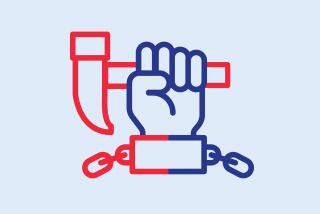The long history of ‘loyalty oaths’
As Geoffrey R. Stone described in his March 11 Op-Ed article, “Loyalty oaths fail the test of democracy,” Marianne Kearney-Brown, a California public school teacher and a Quaker, was fired over her objection to California’s requirement that all public employees sign an oath affirming that they will “support and defend” the United States and California constitutions. Kearney-Brown, who was ultimately rehired, altered the written version of the oath she signed to include the word “nonviolently,” ostensibly because of her religious beliefs.
This controversy has prompted much criticism of California’s oath requirement. One of the most ardent critics is Stone, of the University of Chicago Law School, who wrote in his Op-Ed article that California’s oath and other, as he calls them, “loyalty oaths” across the nation are “un-American” and “anachronistic ... relic[s] of a shameful past”-- that is, the McCarthy era. He also suggested that their effect was to suppress free and critical thought and speech.
Stone is a noted legal scholar, but he is wrong on this issue. Stone has failed to describe fully the history of what he mischaracterizes as “loyalty oaths,” ignored similar provisions that predate the McCarthy era and failed to recognize the true value of these symbolic but still meaningful measures. In seeking to discredit California’s oath, Stone has cast too wide a net and wrongly impugned the value of oaths of office.
Oaths of office are hardly “un-American.” Similar provisions -- state and federal -- have been around since the founding of the country. These oaths, which often are nearly identical to California’s, are not exclusively, nor even primarily, a result of the Red scare or jingoistic passions. To the contrary, it has never been considered a point of shame to require a public servant to pledge a minimum level of fealty to her nation’s and state’s charters. As Justice Thurgood Marshall once agreed, requiring an employee to indicate willingness to “uphold and defend” state and federal constitutions “is clearly constitutional. It is nothing more than the traditional oath of support that we have unanimously upheld as a condition of public employment.”
Our federal Constitution requires that the president and all officers of the United States take an oath. From the nation’s earliest days, this requirement was neither controversial nor viewed as inconsistent with the 1st Amendment right of the people to criticize their government. Indeed, in 1787, Alexander Hamilton referred in Federalist No. 27 to the “sanctity” of the oath requirement, and nearly 50 years later, Justice Joseph Story declared the wisdom of the “solemn obligation” contained in the oath as “a proposition too clear to render any reasoning necessary in support of it.”
Stone may view the oath requirement as “relatively meaningless,” but that view is plainly not consistent with the history of American law. Nor, apparently, is it in line with Kearney-Brown’s view. For if she viewed the oath as meaningless, why would she risk her job by changing it to fit her sensibilities?
Stone also describes California’s oath as requiring loyalty to the government, saying that the “concept of ‘loyalty’ is painfully elusive” and casting doubt on whether a citizen can “oppose government policies” or “be a pacifist” and still be loyal. But these worries concern requirements that simply do not exist in the text of the oath, regardless of the era in which the oath was instituted. Rather, all that is required is a pledge to support and defend the federal and state constitutions, not the present government, officials or policies. Stone’s artful reframing of the oath certainly makes it easier to raise the specter of punishment for disloyalty to the government, but it does so only through linguistic sleight-of-hand and by ignoring the history of California’s oath.
Indeed, California’s Constitution has included an oath of office requiring employees to “support” the federal and state constitutions since at least the late 1800s. The main change wrought by the 1952 amendment Stone refers to was the addition of a separate paragraph affirming that the oath-taker was not “a member of any party or organization, political or otherwise” that advocated the overthrow of the government. That part of the oath was held unconstitutional by the Supreme Court of California in 1967, and it is not now included in the oath signed by state employees, though it remains on the books.
In the end, Stone has used the controversy surrounding Kearney-Brown to advance his view that oaths of office are “un-American.” Yet the conclusion of this dispute is anything but un-American: Kearney-Brown has gotten her job back without having to promise to bear arms against anyone. In return for the privilege of a public job, all that she has promised is to support the charters under which her nation and state exist. Is that really too much to ask?
John Kness, a resident of suburban Chicago, is a lawyer in private practice and a former law enforcement officer.
More to Read
A cure for the common opinion
Get thought-provoking perspectives with our weekly newsletter.
You may occasionally receive promotional content from the Los Angeles Times.









